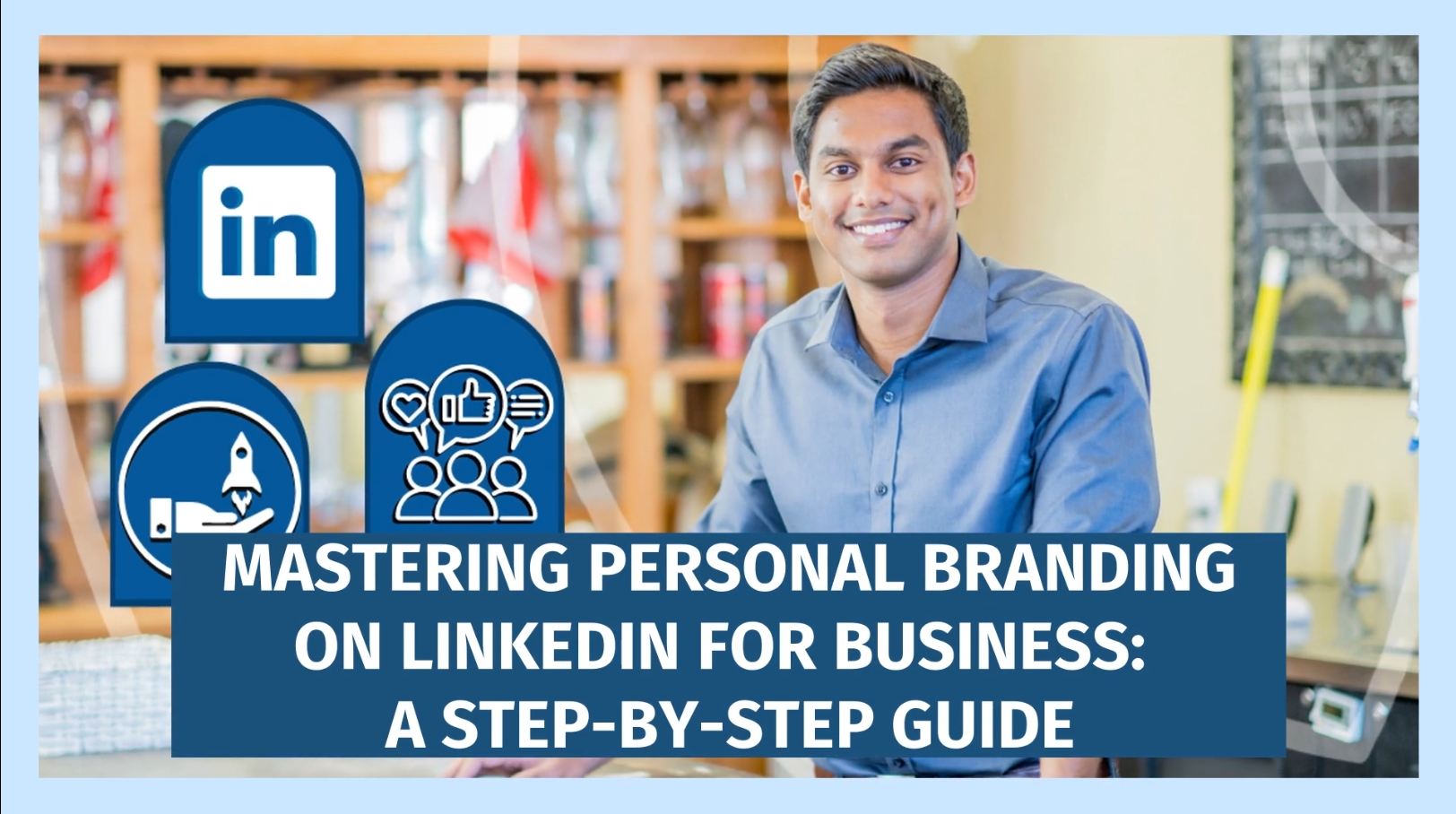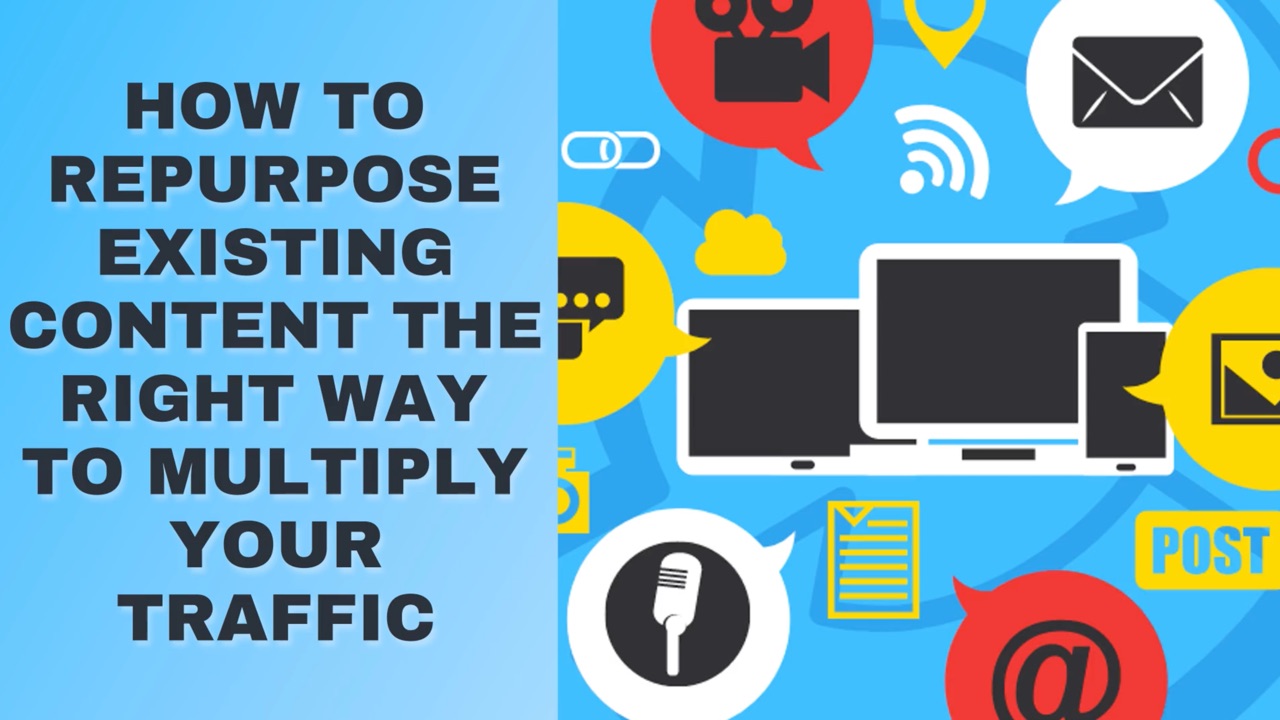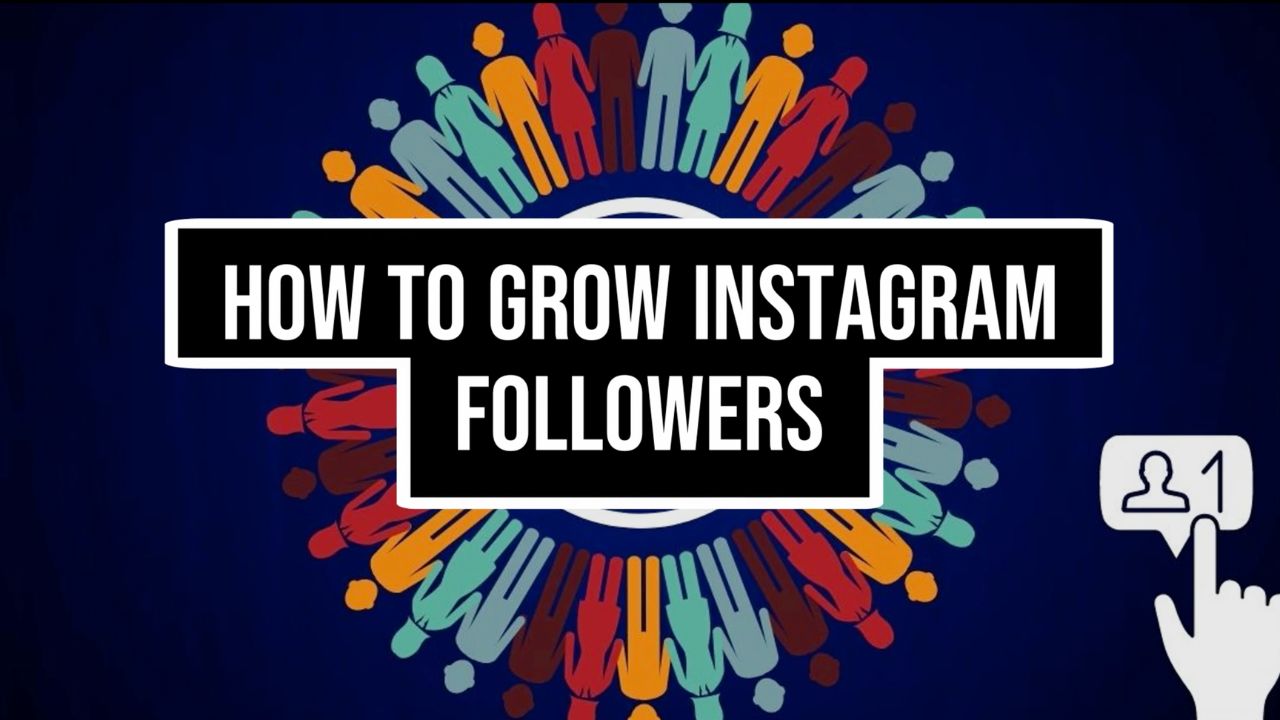LinkedIn, with its huge user base, stands out as a powerful platform for personal branding, particularly for those involved in B2B.
In fact, whether you're an entrepreneur, small business owner, or marketer, taking full advantage of LinkedIn relies upon developing your personal brand on the platform.
So how should you best approach it?
This step-by-step guide provides you with a masterclass for doing just that, with key examples from 5 prominent personal brands for you to model.
We look at:
- Why personal branding on LinkedIn matters…
- The 3 key steps you need to achieve an effective personal brand on the platform…
Let’s get started…
Why Does Personal Branding on LinkedIn Matter?
Did you know that LinkedIn:
- Has more than a billion users, with around half of them active every month (or more frequently)?
- Is preferred by B2B marketers for content sharing and engagement, as well as lead generation?
- Sees conversion rates up to 2x higher?
Caught your attention?
It’s why businesses, particularly those selling B2B, love LinkedIn.
But what about your personal brand? For entrepreneurs and business owners, developing your personal brand on LinkedIn is all but essential.
Here’s why…
It Increases Your Visibility and Credibility
LinkedIn can seem a pretty crowded place, right?
But personal branding sets you apart from the pack by showing what you have to offer that’s distinct from everyone else. Essentially, it’s your USP.
A strong personal brand on LinkedIn that reflects your skills, achievements and distinct personality can establish you as a thought leader and innovator in your industry.
Doing so gives you immediate credibility and boosts your visibility on the platform.

It Generates Opportunities
Want to be a beacon attracting new opportunities that grow your business?
An effective personal brand is key, attracting potential customers and collaborators who resonate with your experience, expertise, vision and overall presence.
As well as attracting new opportunities, you also don’t want to turn any away. Many potential customers and collaborators will check out your presence on LinkedIn—and if it lacks credibility, they’ll simply go elsewhere (and you’ll likely never even be aware).
It Builds a Powerful Network
Would you want to connect with someone whose profile and general presence on LinkedIn is, shall we say, sub-par?
Nor do ‘they’! And ‘they’ can include potential joint venture partners, investors, industry leaders, mentors and customers.
Instead, a well-honed personal brand, where you’re regularly sharing valuable and engaging insights, experiences and content encourages meaningful interactions and connections that can transform your business, help you reach your goals faster, and have more impact.
It Enhances Your Online Presence
A personal brand on LinkedIn that’s consistent with other platforms strengthens your online footprint, grows your authority and credibility, and attracts the right people for all the right reasons!
By being consistent across different platforms, you reinforce your professional image and message, and make it easier for your target audience to both recognize and remember you.
Your personal brand also provides you with a strong foundation from which to both strategically share relevant content, and to engage with your audience, both on LinkedIn and elsewhere.

And Ultimately… It Drives Business Growth!
The real value of personal branding essentially boils down to this…
Personal branding directly impacts your business success, helping to attract customers, clients, investors and others by showcasing the value you provide to the marketplace against a backdrop of your experience, expertise and network.
In other words, it’s a vital part of marketing and growing your business effectively.
So how do you approach it exactly?
Let’s discover the…
3 Key Steps for Effective Personal Branding on LinkedIn
For these three key steps for growing your personal brand on LinkedIn, we’ll be studying and sharing examples from the following 5 prominent personal brands on the platform, with follower counts from between a quarter million to over five million:
- Gary Vaynerchuk (“Gary V”)—serial entrepreneur, CEO, and social media guru
- Alex Hormozi—entrepreneur, author, and business growth expert
- Neil Patel—digital marketing specialist and analytics pro
- Mel Robbins—motivational speaker and best-selling author
- Jay Shetty—former monk, motivational speaker, and storyteller
By studying their approach, we can pull out key insights that can then be modeled to develop and grow your own personal brand on LinkedIn.
Let’s start with the foundational step, optimizing your profile…
Step 1: Optimize Your Profile So It Reflects Your Personal Brand
Your profile is the basis of everything else you do on the platform so it’s important to adjust and optimize it so that it can serve you and promote your personal brand as effectively as possible.
We’ll look at the various elements involved in optimizing your profile, starting with the…
A. Profile Headline
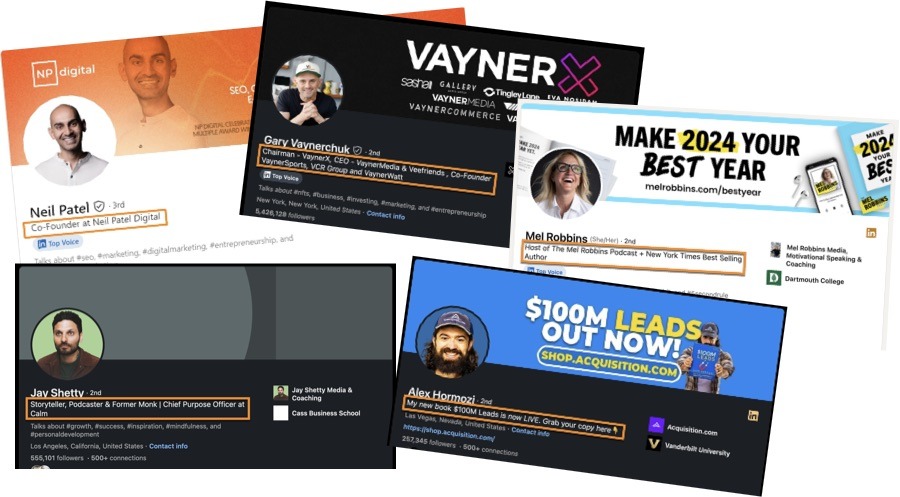
Imagine you’re at a networking event and someone asks you the usual question, “What do you do?”
The title on your profile is where you’re effectively answering that question.
So think about how you want to best represent yourself by answering it, and what your goal is for someone who reads it.
You’ll generally want to lift your authority and credibility levels, while generating enough interest from relevant visitors to explore your profile further.
The majority of the headlines shown in the profiles above take this approach. For example:
- Neil Patel’s is short, sweet, and professional, focusing on his co-founder role. Gary V takes a similar approach, though includes information about various roles.
- Jay Shetty’s sounds more personal, with phrases like ‘Former Monk’ designed to engage and interest the visitor.
- Mel Robbins refers to her podcast and her NYT best selling book.
Each is designed to resonate with and appeal to the exact person they are looking to attract.
Alex Hormozi takes a slightly different approach, with a call to action in his profile headline that encourages visitors to obtain his book. This ties in with his background photo (more on photos below) while at the same time growing his authority, because he has a book to share.
As a general rule though, aim for a headline to be clear and concise, while resonating with the ideal type of person you want to connect with.
As a starting point, think about keywords you might want to include that resonate with your target audience. And have a look at some examples for inspiration.
B. Profile Photo

When you consider that LinkedIn profiles with photos get 14 times more views, It’s surprising that so many profiles do not have one.
So if you don’t have one yet, get one.
And if you do have one, think about how it can be improved.
For best results, a crisp, high-quality shot that gives a positive first impression and where your face can be clearly seen is crucial. Aim to look friendly and approachable.
The ideal dimensions are 400 x 400 pixels, and the file can be up to 8MB. Avoid small, low-resolution images as it will lack clarity on certain devices.
Note your profile photo is not just used on the profile itself, but also adjacent to posts and comments, within connection suggestions for others, and elsewhere.
Looking at the examples of profile photos above, note that neither Mel Robbins nor Jay Shetty are looking straight to camera, with Jay maintaining a more thoughtful pose rather than smiling.
So there’s no hard and fast rule, but think about the impression you want to convey, who you want to attract, and what you want your personal brand to stand for.
C. Background Photo

The background photo shows at the top of your profile, and there are various approaches you can take.
In our examples above:
- Jay Shetty’s (top) is minimal, presumably reflecting his time as a monk and his Calm app
- Alex Hormozi and Mel Robbins encourage visitors to head to the URLs they provide
- Gary V refers to different businesses he’s involved with — and note how the content is towards the right-hand side of the photo, leaving space on the left for his profile pic when displayed on his profile
- Neil Patel highlights the main value he offers to people through his content and services (‘more traffic’), with his website shown in smaller font top right
Again, think about the message you want to convey and the impression you want to leave people with.
If you’re creating your own, Canva has a wide range of templates you can play around with.
D. Profile URL

When you first create a profile on LinkedIn, their default URLs tend to be lengthy with random letters and numbers, and don’t look particularly appealing, professional or something easily shareable.
However, it’s easy to customize it into a shorter URL that:
- Reflects your name and therefore your personal brand
- Is far easier to share and for people to recognize
Ideally, change it to a URL that reflects the exact name you are known by online and that appears on your profile.
However, that may not always be available, in which case try:
- Adding a middle initial (as Neil Patel has done with neilkpatel)
- Swapping your first and last names around (as in Jay Shetty’s example, shettyjay)
E. Contact Information
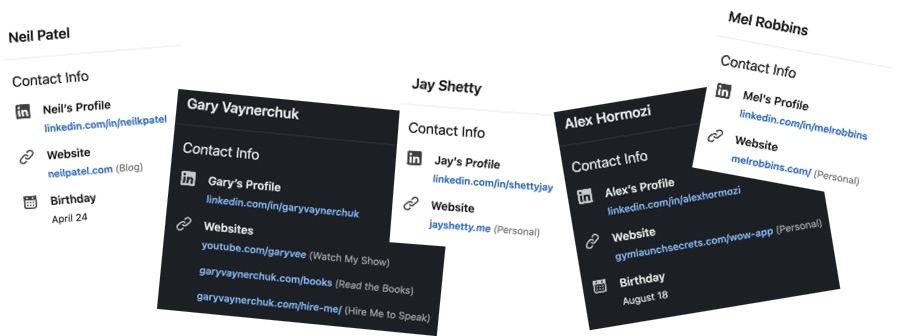
Your profile’s URL is just part of the information that will show on the contact info for your profile page.
Other information includes:
- One or more links to your blog or website — note that in the examples above, only Gary V has included more than one
- Your phone number and email address — you can choose who can view your email address.
F. Featured
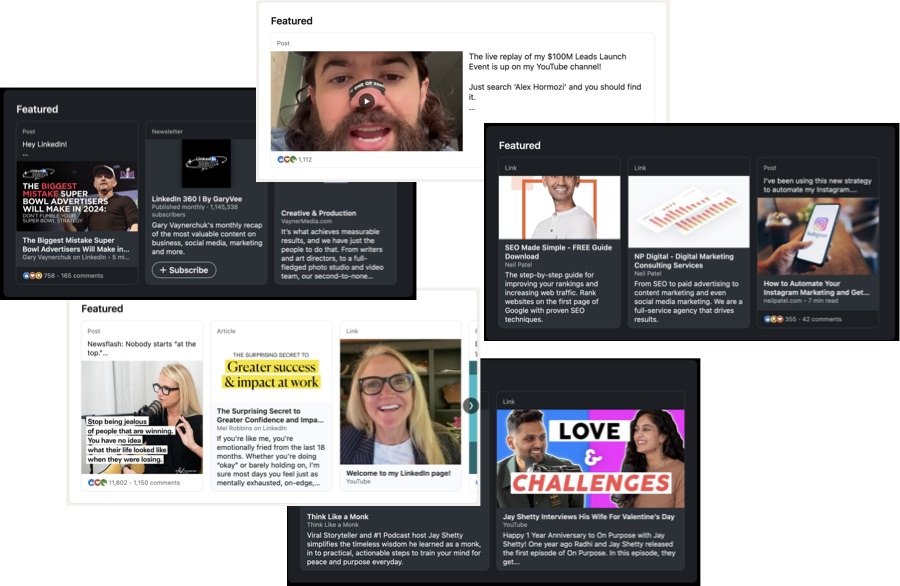
The Featured part of your profile is where you can highlight content such as:
- One of your LinkedIn posts
- A LinkedIn Newsletter, if you have one (more below)
- An article published on LinkedIn (again, more on this below)
- A link to an external resource, such as a video on YouTube or blog post on your website
- Uploaded media
Think about what content you can share in the Featured section of your profile to help grow your personal brand, by giving people the best impression of who you are, what you do and the unique value you provide.
G. About
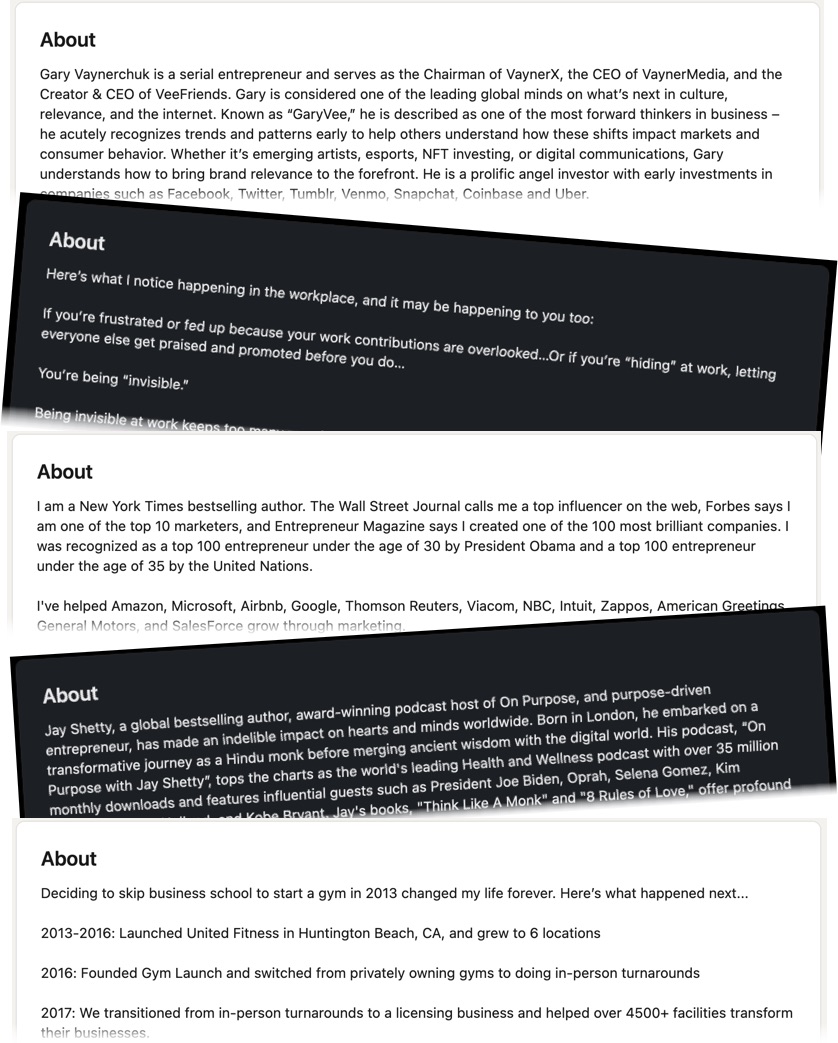
As you can see from the examples above (which are just short excerpts of the originals—click through on the profile links at the top of this section to see them in full), this is where you can go into a lot of detail about your unique story.
Incorporate keywords in the text you provide to make it easier for people to find you on LinkedIn, for example, if they’re looking for a specific skill set or type of person.
It’s up to you whether it’s written in the first- or third-person. For example, Gary V and Jay Shetty take the third-person approach.
It’s a bit like sales copy, but you’re selling yourself in terms of trying to engage the reader so they end up learning (and hopefully remembering) as much about you as possible.
So make it easy to read and engaging, and designed to both:
- Interest the type of person you want to attract…
- Develop and ‘sell’ your personal brand.
For the introductory sentence or two, highlight a key fact or two that you want people to remember (because try as you might, most people will simply scan the top quickly and not read the rest!).
Looking at the above examples:
- Gary V aims to leave the impression of someone who is a serial entrepreneur, mentioning different companies he leads
- Mel Robbins makes it clear she focuses on people’s experiences in the workplace
- Neil Patel immediately builds his credibility and authority by referring to multiple authoritative sources that rate him highly
- Jay Shetty makes it clear he’s an authoritative creator and entrepreneur, with a passion for helping people’s “hearts and minds”
- Alex Hormozi outlines his business growth story, indicating his authority for helping others do the same
H. Experience
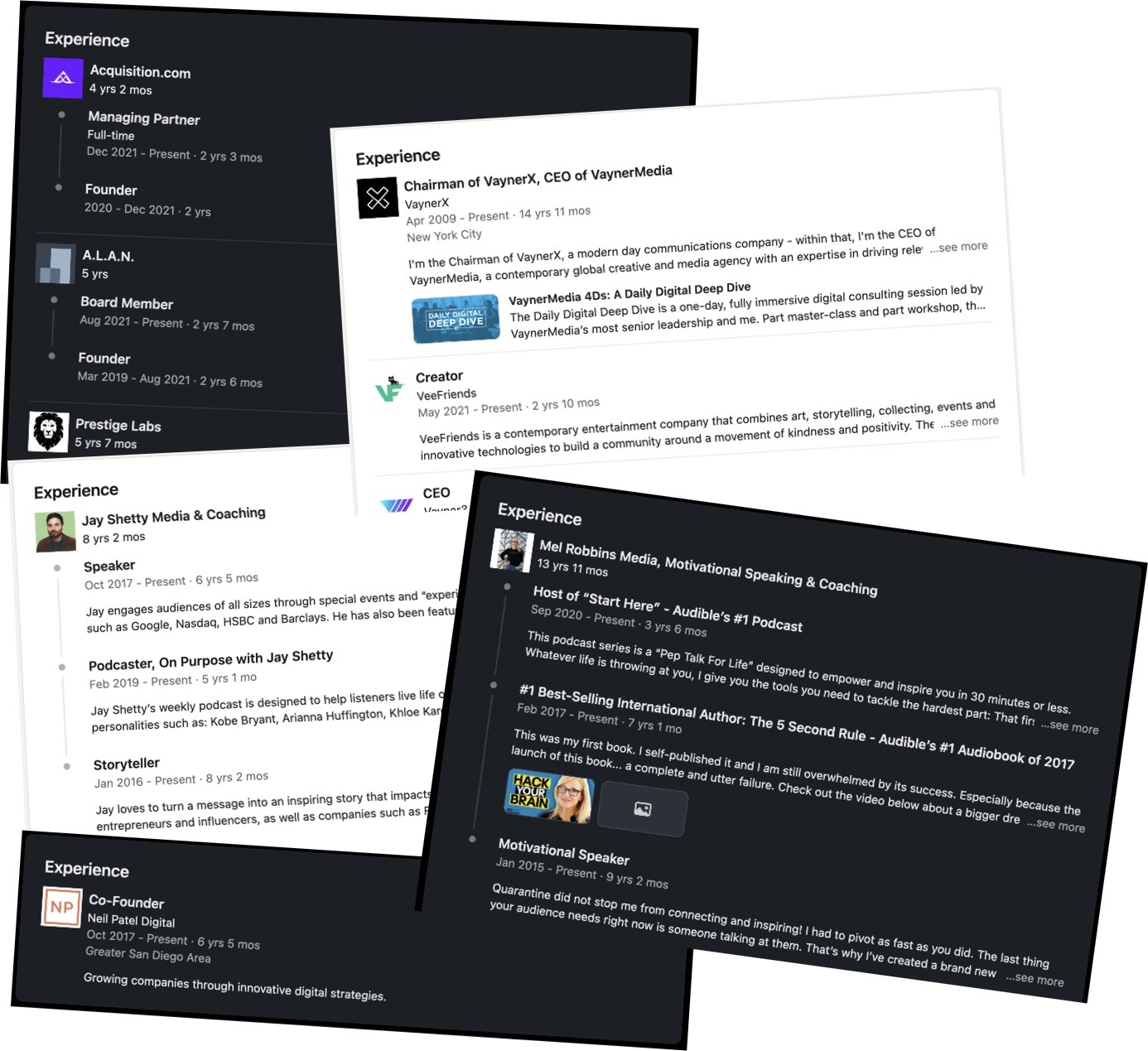
In the Experience section, highlight achievements that help to reinforce your personal brand and that will resonate with your ideal audience.
You can approach it in different ways, for example:
- As illustrated above, Jay Shetty and Mel Robbins have structured their experience section to highlight different achievements or milestones within one of their roles.
- Neil Patel, has included just one role, despite other experiences he’s had
I. Other Sections

Have a look through some of the other sections, and fill out those you determine as relevant for the type of personal branding you want to convey.
As you can see from the examples above, there’s a wide variation in what’s determined to be useful or relevant.
Alex Hormoze and Neil Patel have taken a relatively minimalist approach, while the other three have added content to many of them, with some variations in the sections chosen.
These sections include the following:
- Volunteering—showcase your volunteer work and non-profit contributions
- Projects—highlight specific projects you've contributed to or led
- Skills—list your professional skills for endorsements.
- Publications—share books, articles, or research you've published
- Recommendations—invite and display endorsements from colleagues and clients
- Honors & Awards—list received recognitions and achievements
- Languages—indicate languages you speak and your proficiency level
Step 2: Share Valuable Content, Regularly and Consistently
Your profile might now be optimized, but it’s of little use unless people in your intended audience know it exists and come view it.
And personal branding on LinkedIn is more than just having an optimized profile.
It’s also about showing up regularly and consistently on the platform, and in so doing, developing an audience.
You do that by creating and sharing original content on a regular, consistent basis.
Here are six different ways to approach it…
A. Share Insights
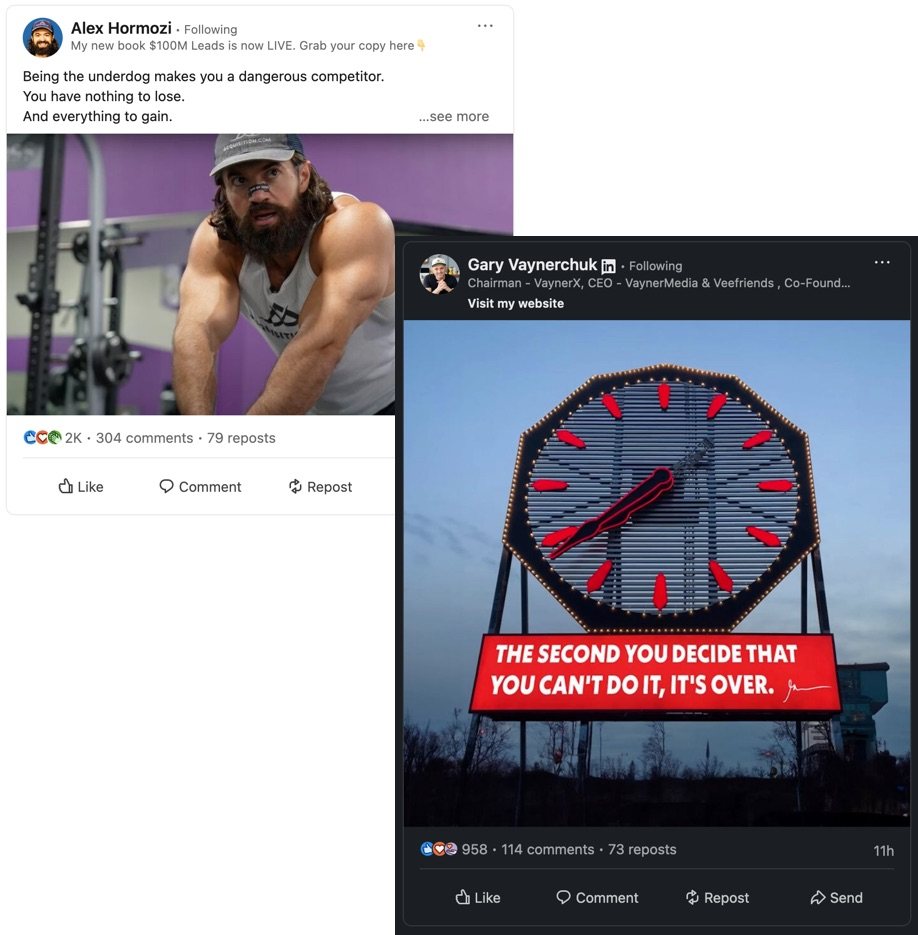
Post useful insights that are relevant for the personal brand you want to promote, along with engaging media to help capture the attention of your audience and add value.
B. Start Discussions and Conversations
Try using LinkedIn Polls as an easy way to get some quick engagement from your audience, while also gaining insights into how your audience thinks and what they believe.
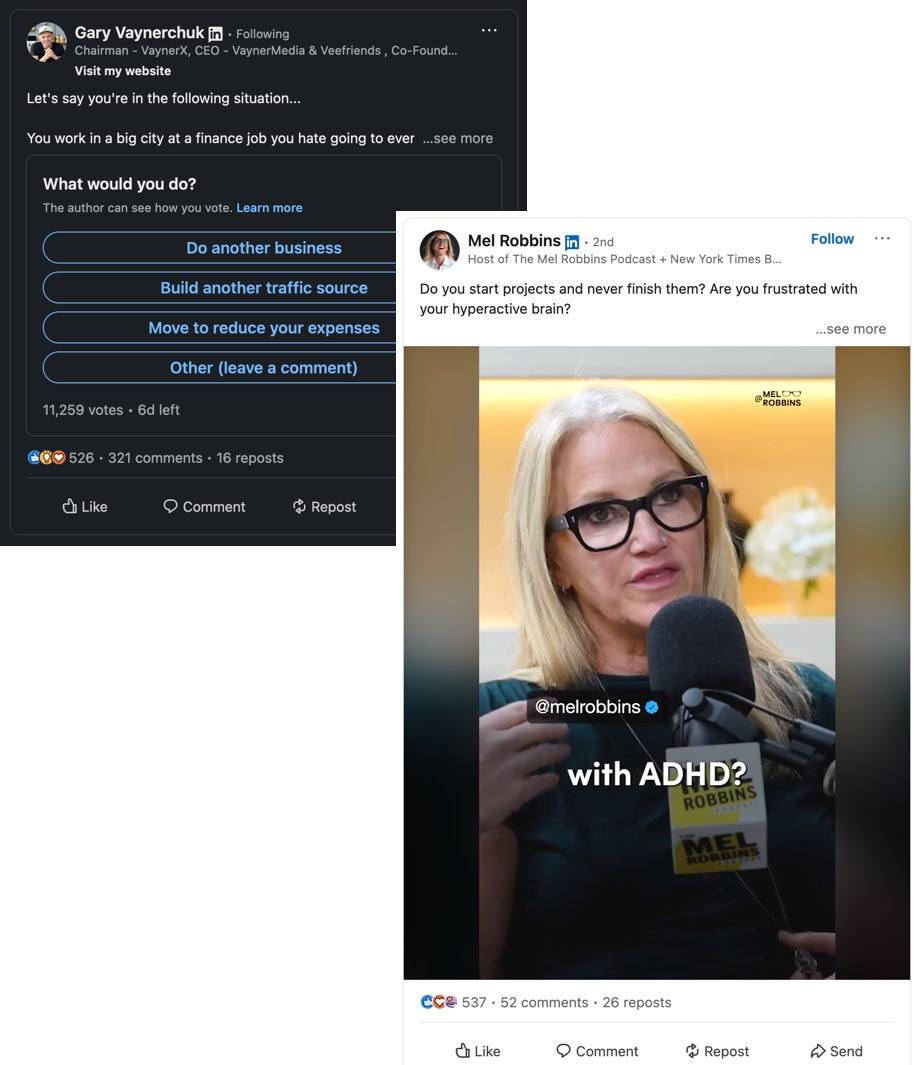
In addition, share posts that spark interest in the type of person you want to attract, and that initiate meaningful conversations and discussions to help build the relationship with them, and help them remember you as someone who offers value.
C. Share Video Content
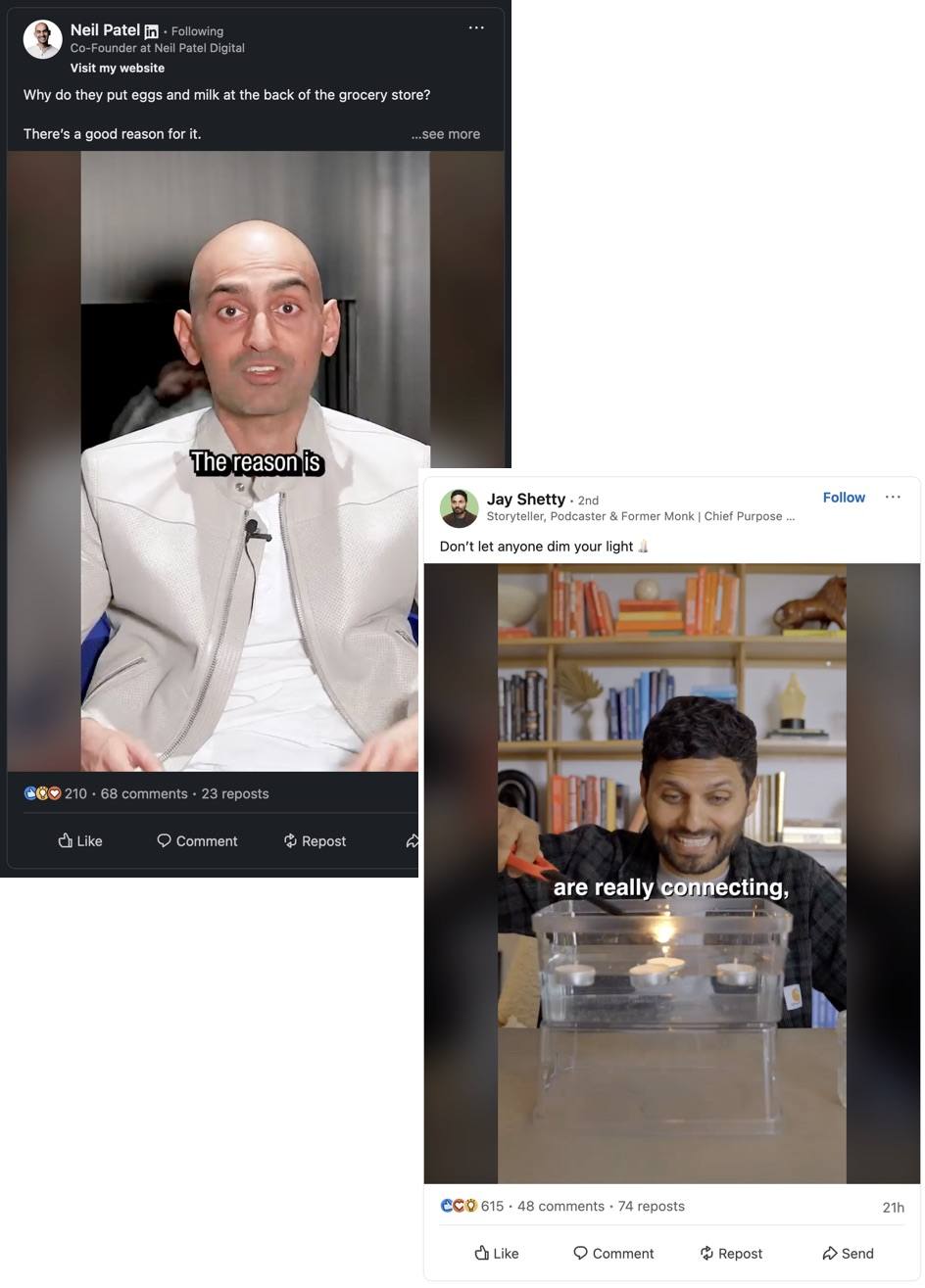
Video content is one of the most engaging types of post on the platform, and many prominent individuals who’ve developed personal brands on LinkedIn use it almost exclusively.
Video content can include going live on the platform, as well as uploading videos as standalone posts (that can also be posted elsewhere such as TikTok).
D. Share Written Content
What about written content?
Posts that link to content outside of LinkedIn, such as posts that share blog posts on your website, don’t achieve as much organic engagement as they used to.
That’s because LinkedIn, like other platforms, want to hold on to their users for as long as possible.
But you can pay to sponsor such content (and other types of post), targeting those most likely to be interested in engaging with it.
What you can also do is repurpose long-form content like blog posts as articles that are published directly on LinkedIn. Here’s a quick overview of how it works (or click here for the full guide):
E. Start a LinkedIn Newsletter

Try starting a LinkedIn Newsletter to deepen engagement with your network.
Share your expertise and passions, build a community around your interests, and establish yourself as a go-to source in your field.
F. Leverage LinkedIn Analytics
Understanding the performance of your content and engagement on your profile is key to refining your LinkedIn strategy. LinkedIn's analytics provide valuable insights into how your posts are received and who is interacting with your profile. Here's how to use them effectively:
- Access your analytics—navigate to your profile's Activity section to view metrics for your posts, articles, and videos.
- Analyze engagement metrics—look at likes, comments, shares, and views to gauge what content resonates most with your audience.
- Profile visits—check the number of profile visits to understand the impact of your content on drawing attention to your profile.
- Audience insights—explore the demographics of your viewers and followers, including job titles, industries, and geographic locations.
- Adjust content strategy—use these insights to tailor your future posts, focusing more on topics and formats that engage your audience.
Regularly reviewing LinkedIn analytics empowers you to make data-driven decisions, enhancing your personal brand's visibility and engagement on the platform.
Step 3: Strategically Grow Your Connections
While your connections on LinkedIn will grow organically as a result of sharing content regularly and consistently in the ways described above, there’s more you can do to accelerate your results (especially if your network is relatively small, which it’s likely to be if you’re just getting started).
Here are four key ways to approach it…
A. Actively Engage
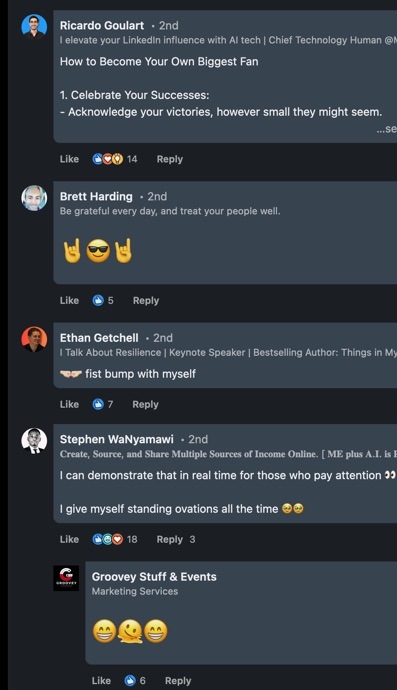
Actively engaging with others is crucial, rather than just expecting others to come engage with your content. To do so:
- Interact with your existing connections—like, comment and share content from those already in your network to both maintain and help deepen those relationships…
- Respond promptly—show that you’re active, by responding in a timely manner to those who comment on your posts and message you…
In addition…
B. Join Relevant Groups
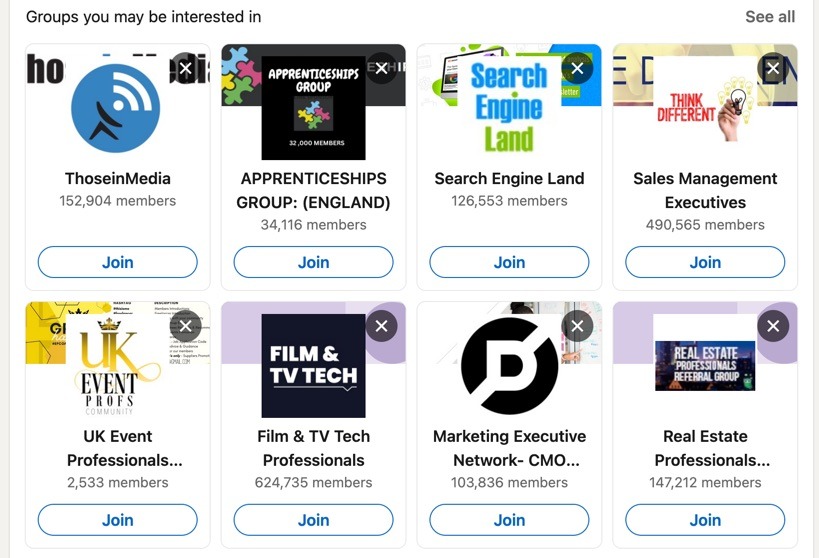
Find and join groups related to your industry or the interests of your intended audience.
Contribute regularly, such as by providing useful insights, asking questions, and providing valuable feedback.
Engage in discussions to help grow your visibility, and stimulate the interest of others to visit your profile, find out more about you, and connect.
C. Networking and Collaboration
Here are some ways in which you can collaborate with other LinkedIn users to help grow your network and your overall visibility:
- Joint content creation—partner with peers to create articles or posts that share your combined expertise
- LinkedIn Live sessions—co-host live discussions on topics of mutual interest, piggybacking on their potentially larger audience
- LinkedIn Events—collaborate on webinars or workshops, inviting your networks to join
- Create a LinkedIn Group—we’ve discussed finding Groups above, but how about creating your own and then inviting others to contribute and share?
D. Make and Accept Connection Requests
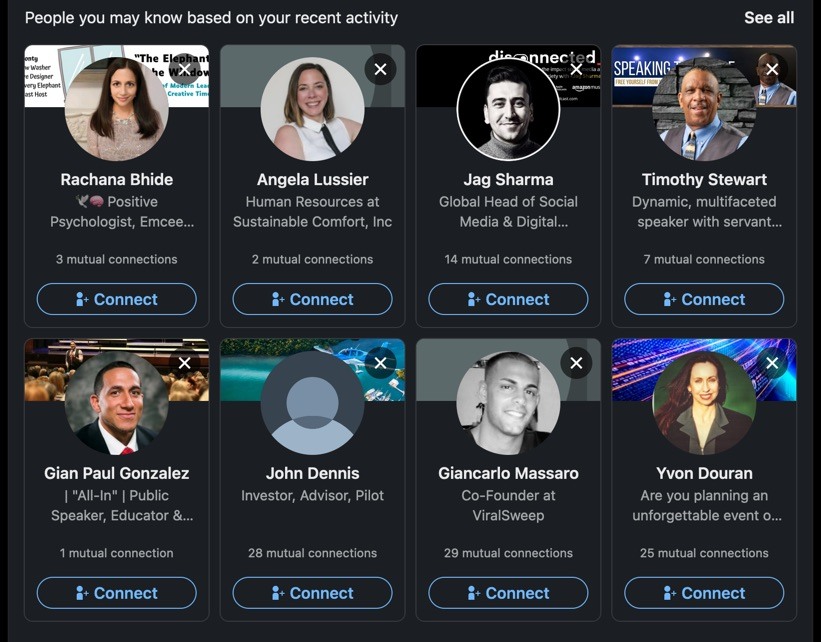
Take a look at the 'People you may know' section via the My Network section on LinkedIn.
The platform excels at suggesting connections you might already know—you'll find profiles with names, job titles, and companies, and likely some familiar faces. You can send connection requests with a single click.
For best results, personalize your requests with a brief note on why you’re reaching out and what you have in common. Personalizing this as much as possible increases the likelihood of a positive outcome and a new connection for the future.
Avoid being overly promotional. Just reach out for the sake of making genuine personal connections, and take it from there.
To Conclude
As we’ve seen, effective personal branding on LinkedIn involves first setting the stage by getting your profile set up in the right way, followed by regularly sharing useful and engaging content, and growing your network with additional activities.
But the most important bit is this. You’ve got to keep showing up!
Don’t worry about making mistakes, they’re bound to happen if you’re turning up regularly. But they’re also quickly forgotten.
By consistently showing up, you’ll constantly improve, your network and levels of engagement on the platform will grow over time (just be patient enough for this to happen!), and your personal brand on LinkedIn will become increasingly prominent and help fuel the growth of your business.
